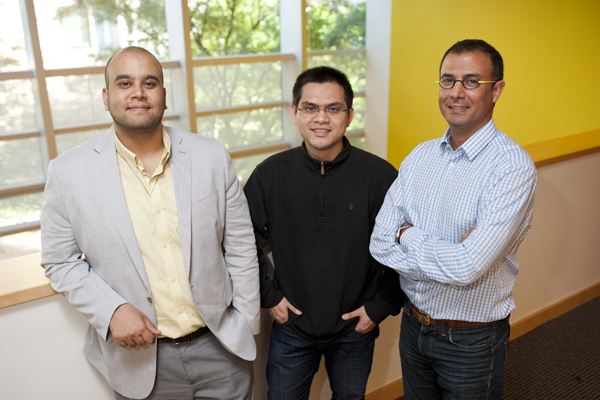Researchers push the radio rainbow’s limits

Back when walkie-talkies and car radios represented the height of wireless technology, there were plenty of frequencies to go around. The spectrum of radio waves was easily parsed into discrete packets: one for the oldies station, one for playing cops-and-robbers in the woods behind your house, several for real police officers and for military communications.
But with the increasing use of wireless devices, that spectrum is getting clogged. “You cannot create more frequency,” explained Guevara Noubir, a professor in the College of Computer and Information Science. “The spectrum is like a natural resource—it has to be shared by everybody.”
The problem of wireless interference isn’t limited to things like dropped calls, which we might be more familiar with. Noubir said it also presents a significant security challenge as adversaries may intentionally jam communications.
The Federal Communications Commission, or FCC, announced in June that it would expand a presidential directive to identify more frequency bandwidth through policy and best practices. But as quickly as bandwidth is freed up, new wireless technologies enter the market demanding even more.
Since creating new spectrum would be as easy as generating petroleum fuel out of thin air, researchers like Noubir are setting their sights on better wireless systems that more effectively use the frequencies we’ve got. Toward that end, the Defense Advanced Research Projects Agency, also known as DARPA, has rolled out a first-of-its-kind Spectrum Challenge to design and build a software defined radio from the ground up that address today’s challenges.
In a preliminary round earlier this year, 90 research teams from around the country watched their software-defined radios attempt to dominate their competitors in one section and then to cooperatively share the spectrum in a second. In that first event, the pool was reduced to just 18 teams, which faced off again earlier this month.
Comparing wireless communication systems and algorithms is can be difficult, given the challenge of reproducing the environment for radio wave propagation. In order to create a level playing field for wireless systems comparison, the tournaments were physically run on a synthetic testbed at Rutgers University.
Noubir’s team, which also includes former graduate student Bishal Thapa and current doctoral candidate Triet Vo-Huu, has consistently dominated the pack. Since the 1990s, when Noubir helped develop the world’s first 3G network, he and his colleagues have developed various techniques for efficiently blocking communications as well as overcoming smart attacks transmitted by others on the same frequency wave. “Our techniques draw from communications and coding theory, algorithmic game theory, and software defined radio,” he explained.
Their software earned Noubir’s team first place in this month’s cooperative section and third in the competitive section. Theirs was the only team to place in the top three in both sections, as well as the only team to retain its high-level standing in the preliminary round. Their achievements were met with a $25,000 prize from DARPA.
The next event in the challenge will be held in March 2014, when the same teams will compete again with similar rules and toward a similar goal. “We’ll be spending the next six months making smarter techniques on top of the foundation we’ve already created,” Noubir said.





